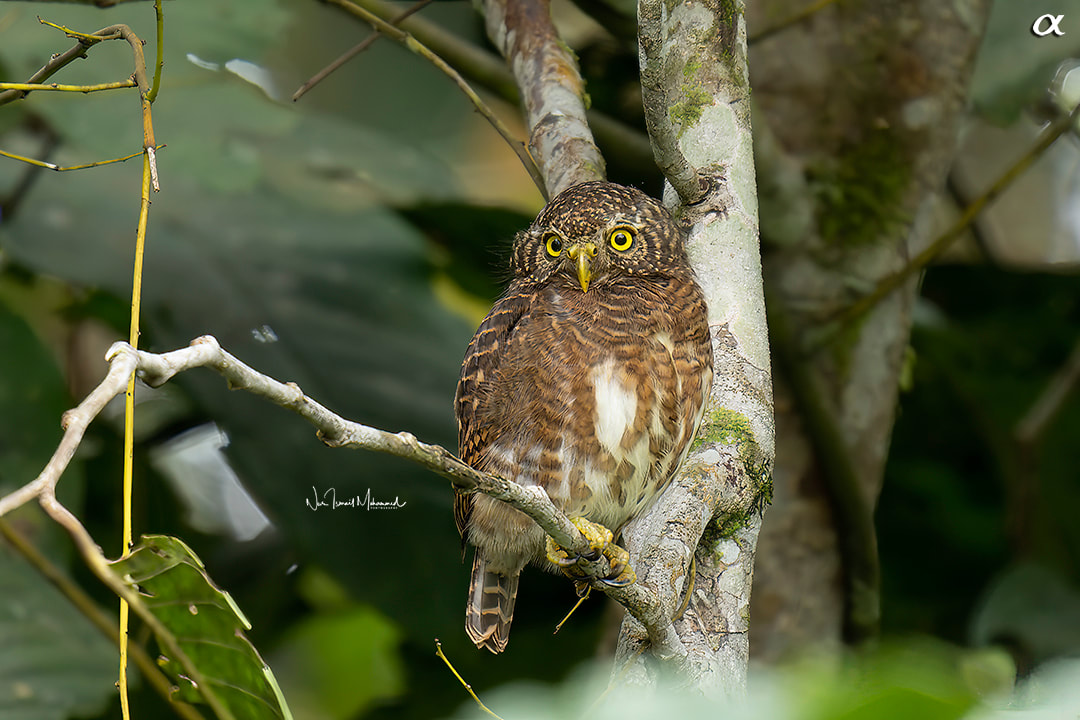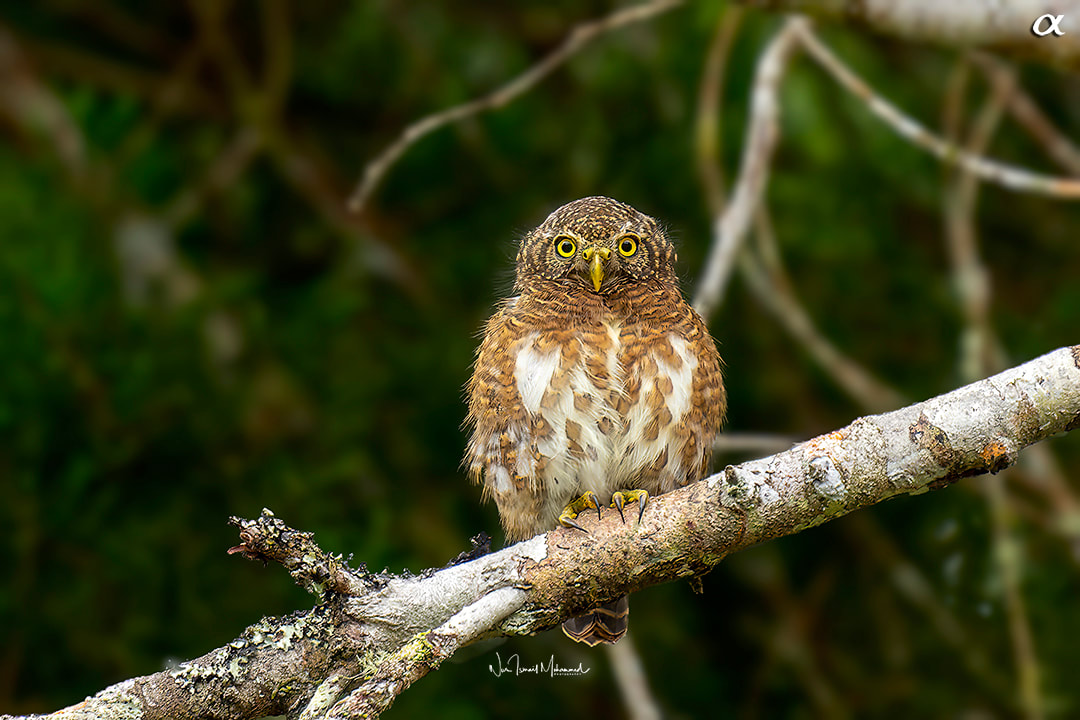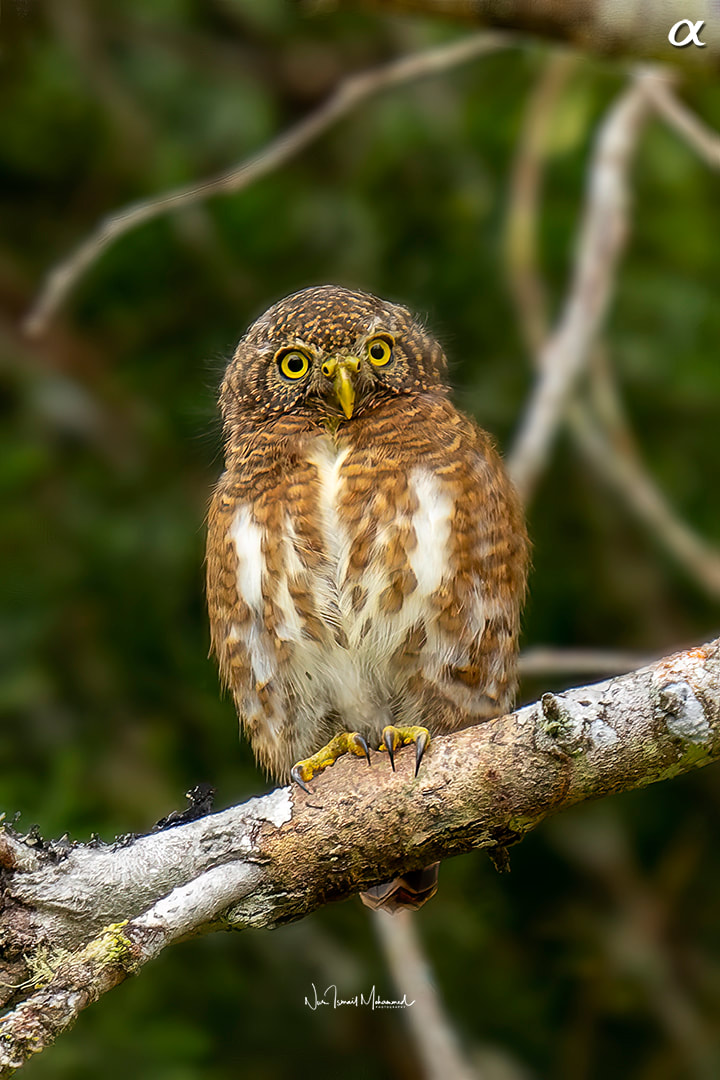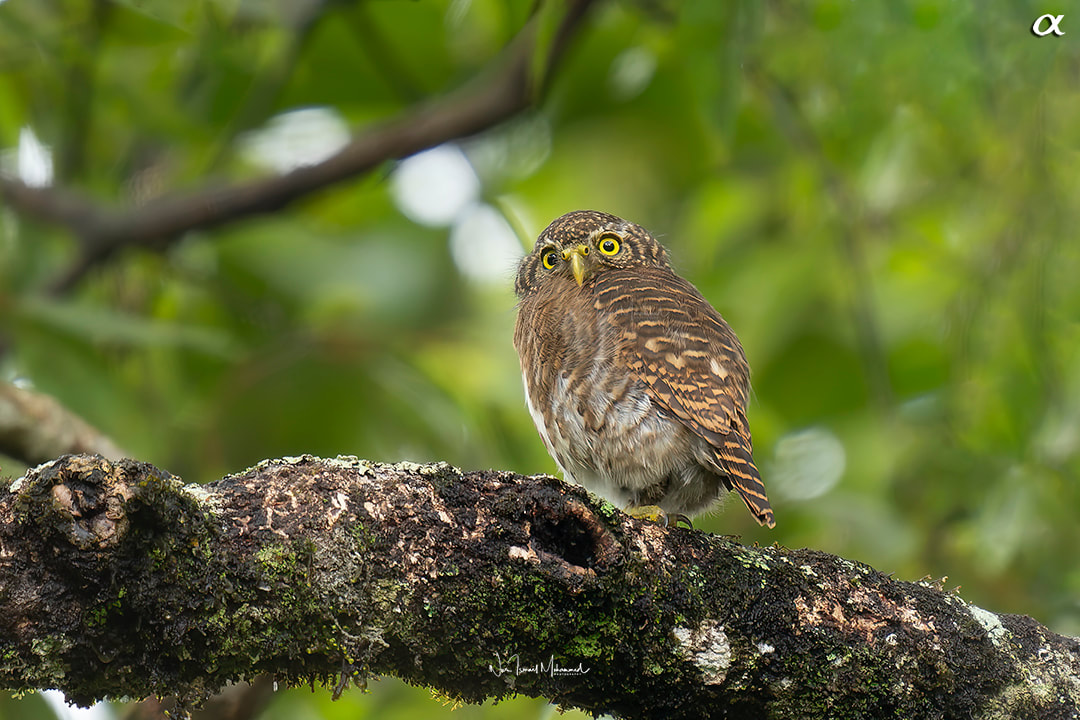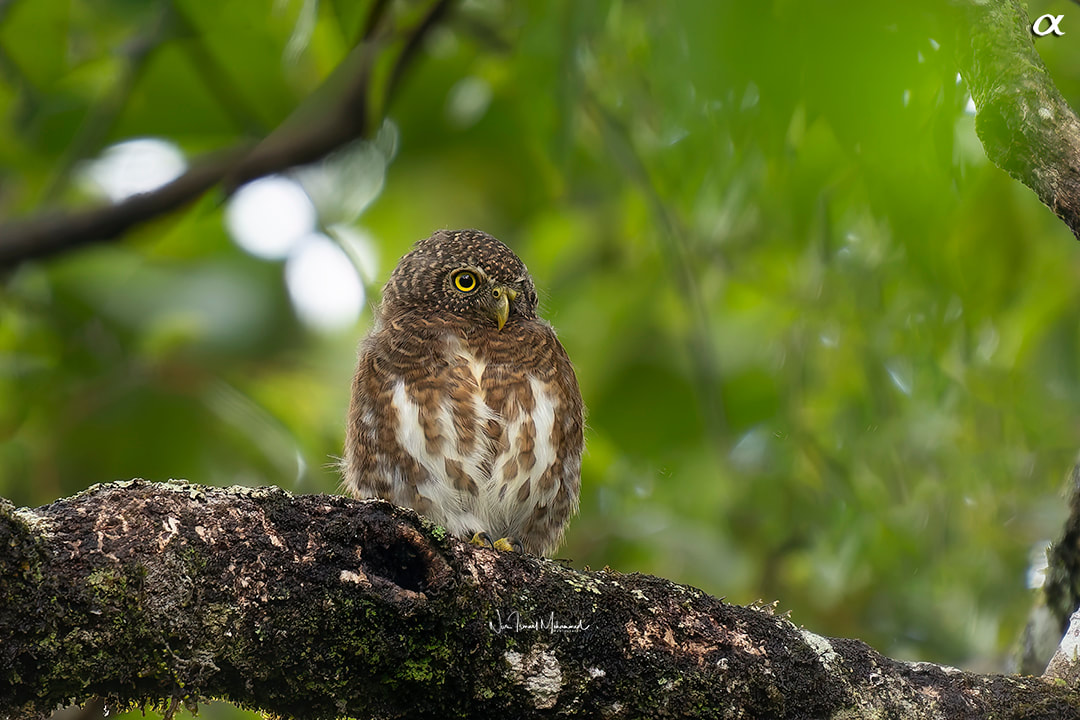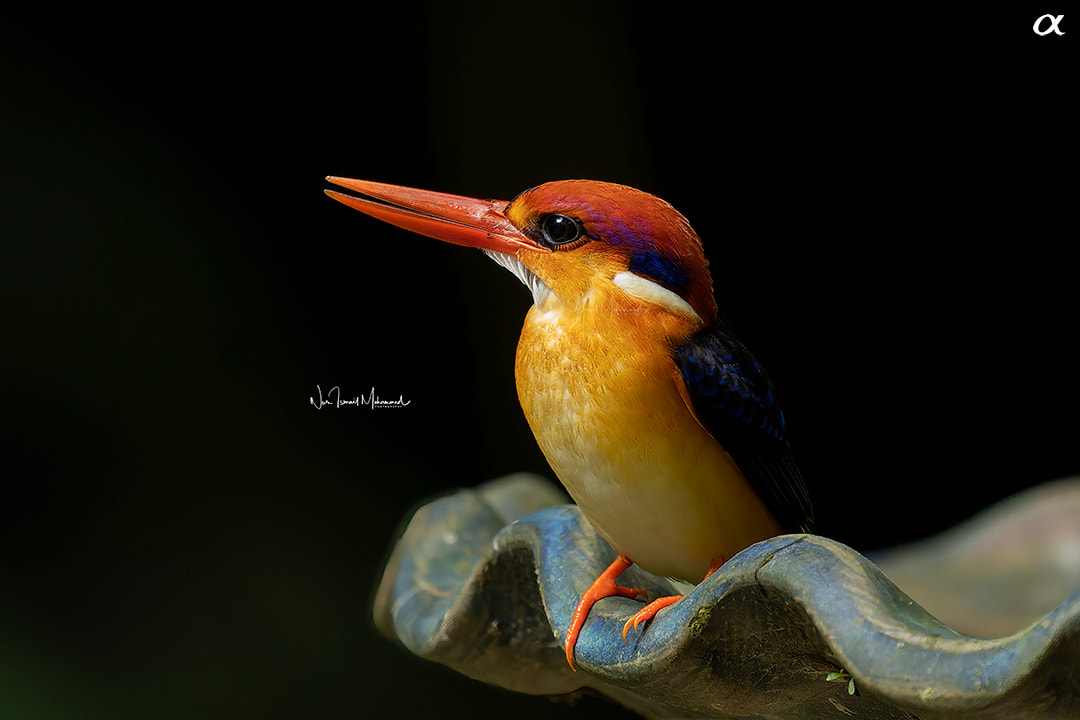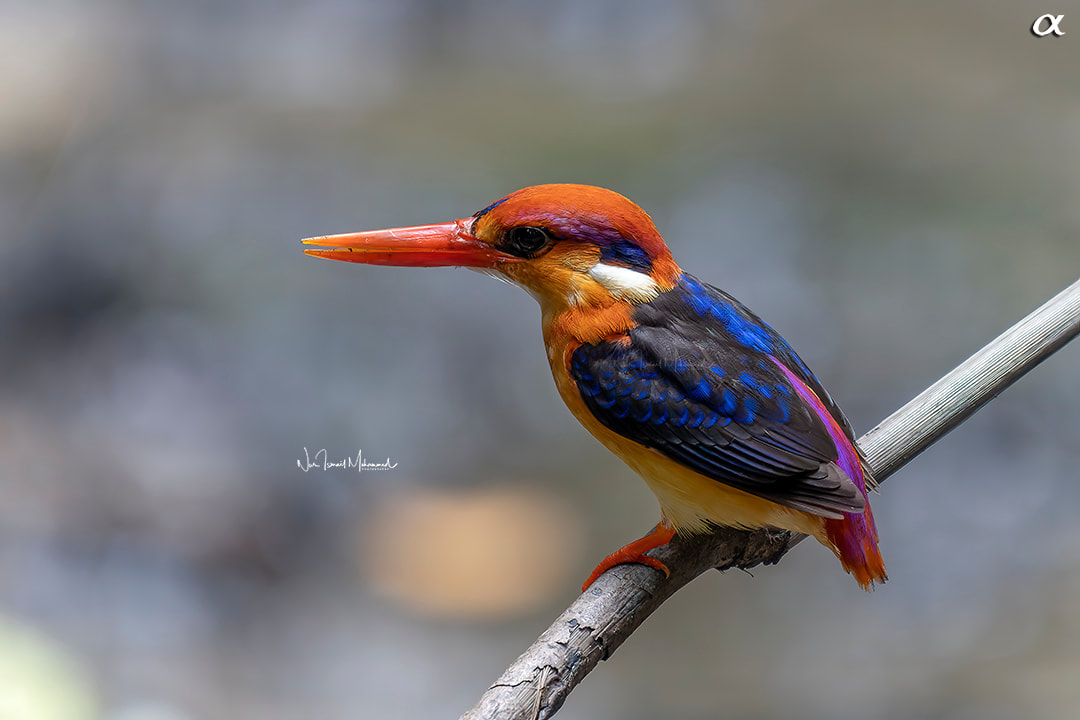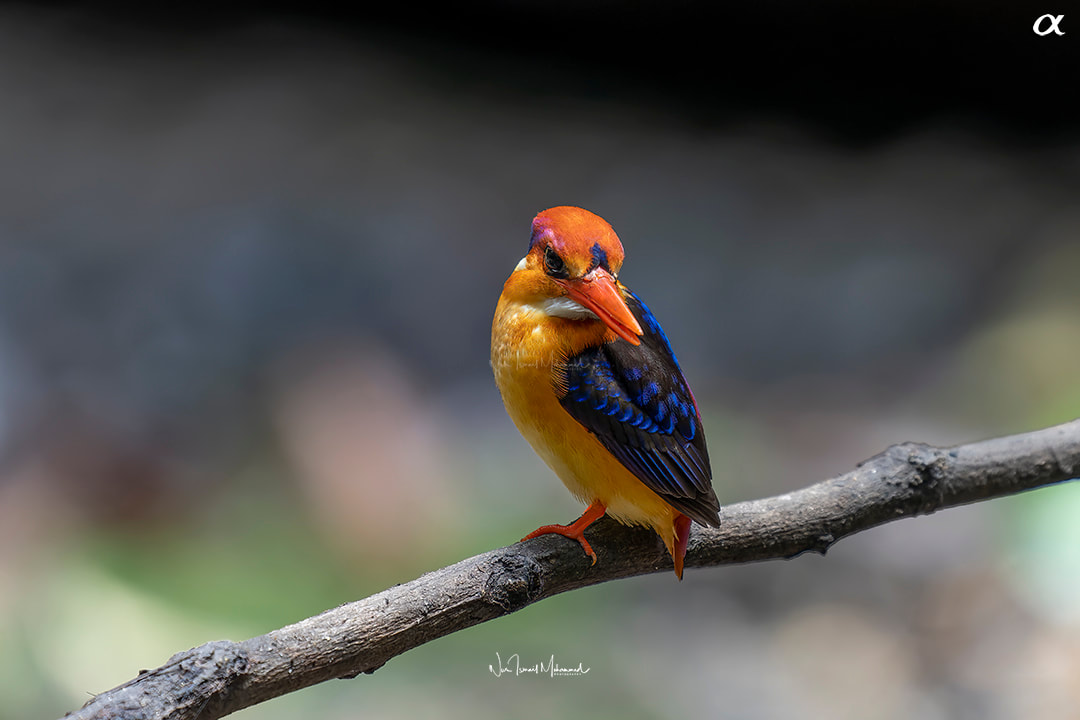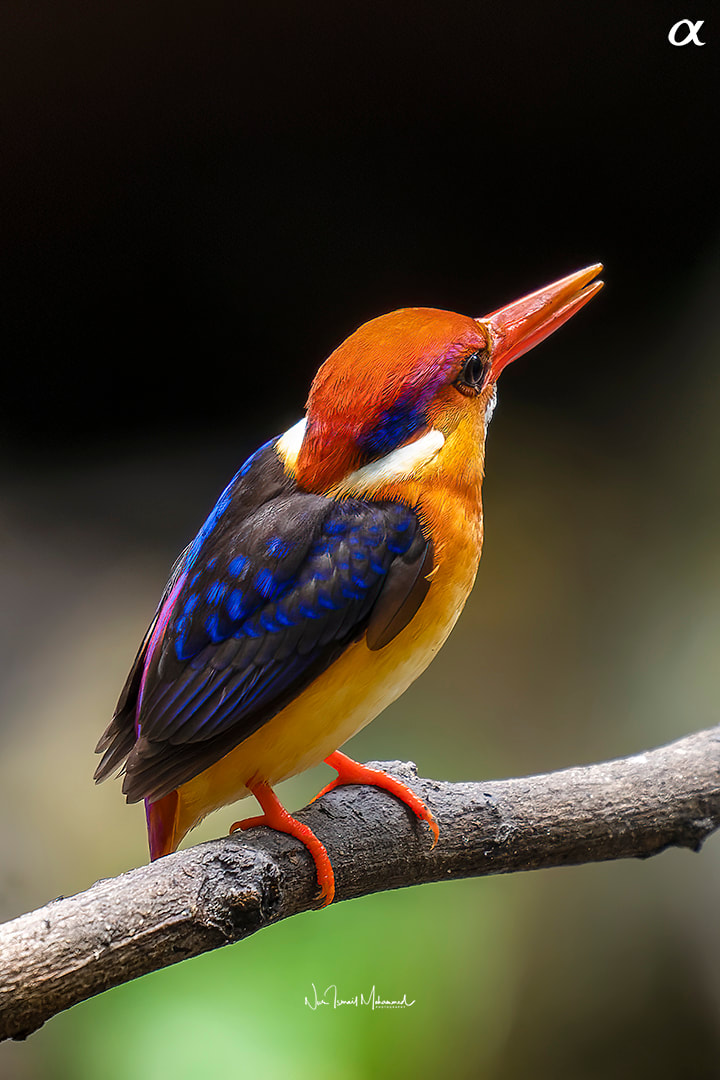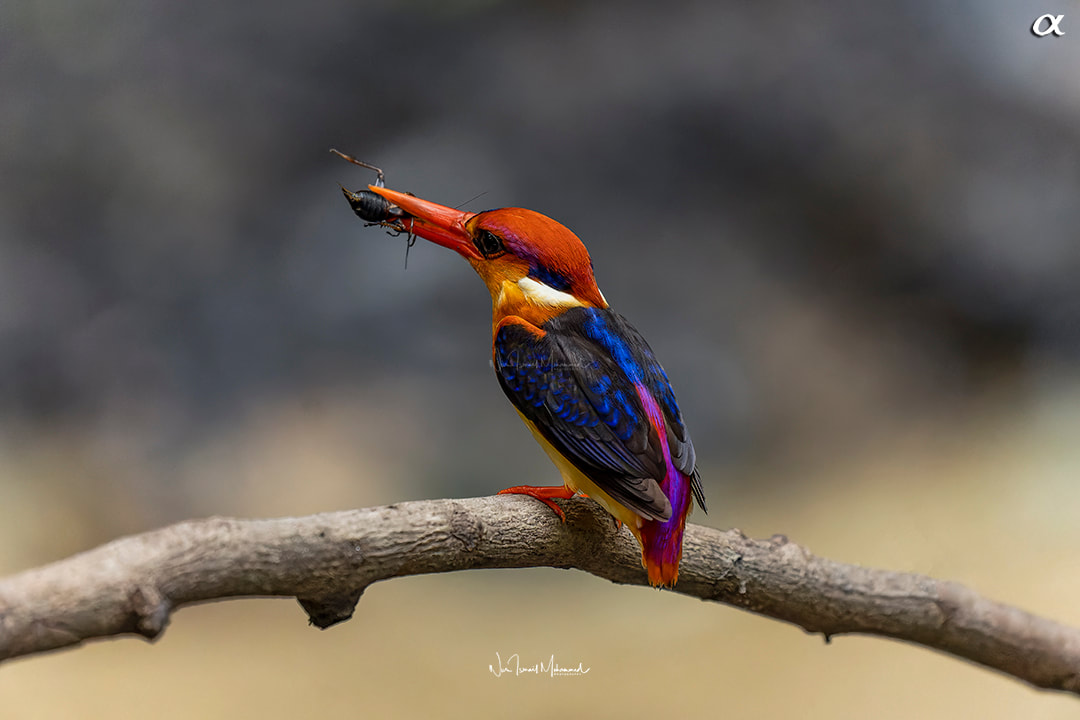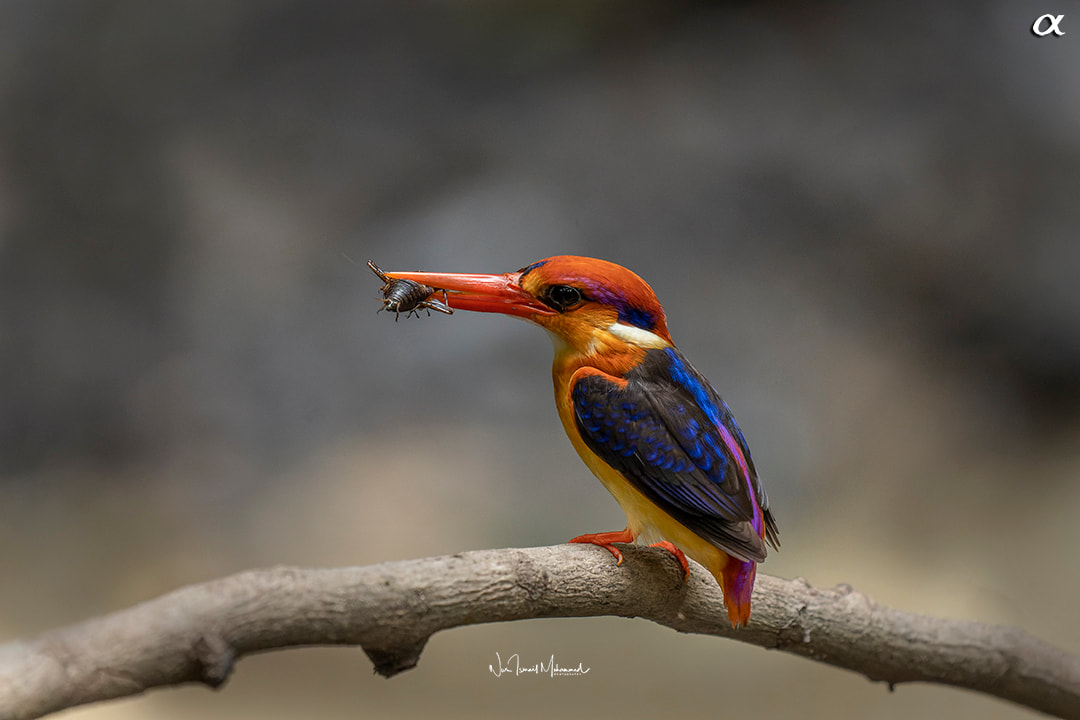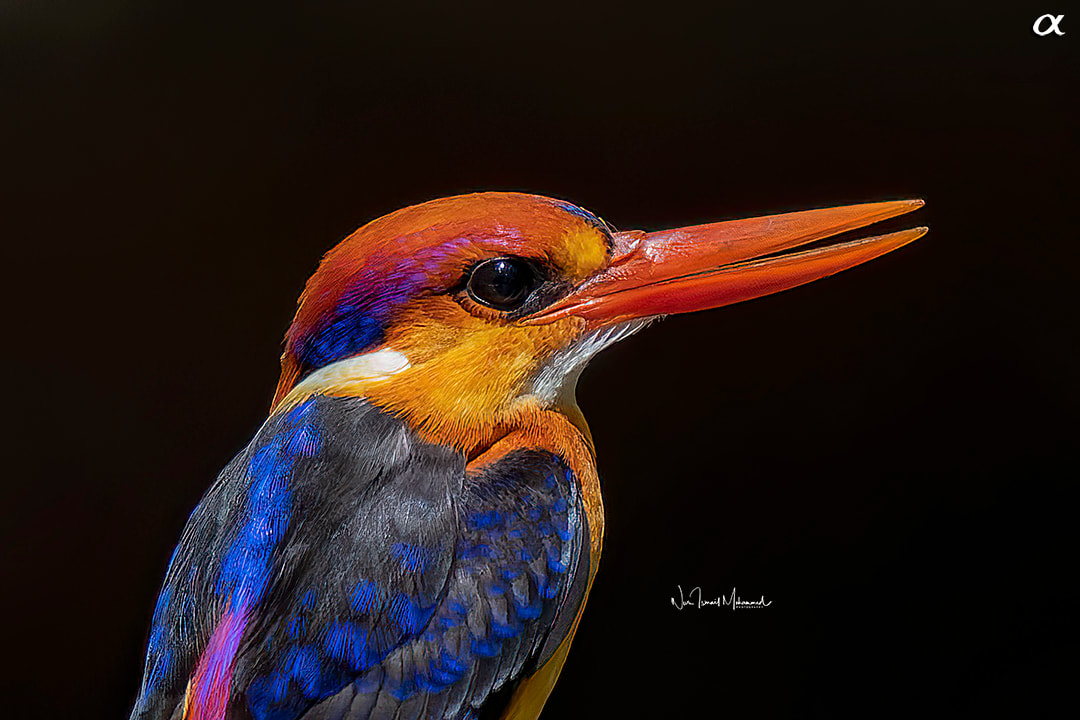|
Glaucidium brodiei or commonly known as the collared owlet is the smallest owl in Asia measuring about 15 cm in length. This species is a tiny owl with a rounded head and no ear-tufts and is also known as the collared pygmy owl. Its natural habitat is temperate forests. It feeds mainly on small birds and will also take mice, lizards, cicadas, grasshoppers, beetles and other large insects. The collared owlet has rufous or greyish upperparts with dark brown barring on its mantle, wings, tail and on the sides of its upper breast, a relatively large, rounded head with tiny buffy spots and bright yellow eyes. There are two large orange and black eyespots on the back of the neck. The underparts are white with a brown bar across the throat and rufous brown "droplet" shaped spots along the sides. The females are usually heavier and larger than the males. [Source: MyBIS] This collared owlet was captured during my recent 3D2N outing at Fraser's Hill with like-minded friends. Stayed at Shahzan Inn Hotel, as usual, but, after my recent experience, it is about time to try out a different accommodation for my next trip. Name: Collared owlet Scientific: Glaucidium brodiei Malay: Burung Hantu Kecil / Hantu Kecil / Pungguk Kerdil Bercekak Family: Strigidae IUCN Red List (v3.1, 2016): Least Concern Gear: SONY a1 + SEL200600G + SEL14TC. Location: Fraser's Hill, Pahang, Malaysia #NurIsmailPhotography #sony #sonymalaysia #a1 #SEL200600G #alpha #AlphaGuru #SAG #DXO #PureRAW #topazlabs #leofoto #pg1 #Fight4ourPlanet #DiscoverWithMYAlpha #DiscoverWithAlpha #AlphaUniverseMY #FullFrameLife #MySONYLife
Copyright © 2021 Nur Ismail Photography. All rights reserved. Do not use or reproduce these images on websites, blogs or publications without expressed written permission from the photographer. For any enquiries, please visit my website: www.nurismailphotography.com or email at [email protected]. Flickr: www.flickr.com/photos/nurismailphotography/
0 Comments
A large songbird Melanochlora sultanea or commonly known as the Sultan Tit is measures about 17-20 cm in length. This species can be found in lowland forests and hill forests, up into the lower montane forests. It feeds mainly on insects but sometimes consumes figs. The Sultan Tit is the only member of the monotypic genus Melanochlora. It has a forehead and crown with the brilliant yellow crest, dark bill, black upperparts plumage and yellow underparts. Males and females are look alike. The female has greenish black upperparts and yellowish throat. While the young resemble the female, during its youngest stage, the bright edges to the plumage of the upper parts are absent, and the greater wing-coverts are edged with white. [Source: MyBIS] Name: Sultan tit Scientific: Melanochlora sultanea Malay: Serai Bakau / Serai Raja Family: Paridae IUCN Red List (v3.1, 2016): Least Concern Gear: SONY a1 + SEL200600G + SEL14TC. Location: Fraser's Hill, Pahang, Malaysia #NurIsmailPhotography #sony #sonymalaysia #a1 #SEL200600G #SEL14TC #alpha #AlphaGuru #SAG #DXO #PureRAW #topazlabs #leofoto #pg1 #Fight4ourPlanet #DiscoverWithMYAlpha #DiscoverWithAlpha #AlphaUniverseMY #FullFrameLife #MySONYLife #FrasersHill
Copyright © 2021 Nur Ismail Photography. All rights reserved. Do not use or reproduce these images on websites, blogs or publications without expressed written permission from the photographer. Here is a collection of the video footage of the Red-headed trogon taken at Fraser's Hill, Pahang. Name: Red-headed trogon Scientific: Harpactes erythrocephalus Malay: Kesumba Gunung / Kesumba Kepala-merah Family: Trogonidae IUCN Red List (v3.1, 2016): Least Concern Gear: SONY a1 + SEL200600G. Location: Fraser's Hill, Pahang, Malaysia #NurIsmailPhotography #sony #sonymalaysia #a1 #SEL200600G #alpha #AlphaGuru #SAG #DXO #PureRAW #topazlabs #leofoto #pg1 #Fight4ourPlanet #DiscoverWithMYAlpha #DiscoverWithAlpha #AlphaUniverseMY #FullFrameLife #MySONYLife #FrasersHill
Copyright © 2021 Nur Ismail Photography. All rights reserved. Do not use or reproduce these images on websites, blogs or publications without expressed written permission from the photographer. For any enquiries, please visit my website: www.nurismailphotography.com or email at [email protected]. Flickr: www.flickr.com/photos/nurismailphotography/ This is my video collection of the Collared owlet, taken at Fraser's Hill recently. Pardon me for the "extra" voices of the excited photographers. The footages were taken with SONY a1 + SEL200600G + SEL14TC. Name: Collared owlet Scientific: Glaucidium brodiei Malay: Burung Hantu Kecil / Hantu Kecil / Pungguk Kerdil Bercekak Family: Strigidae IUCN Red List (v3.1, 2016): Least Concern Gear: SONY a1 + SEL200600G + SEL14TC Location: Fraser's Hill, Pahang, Malaysia #NurIsmailPhotography #sony #sonymalaysia #a1 #SEL200600G #SEL14TC #alpha #AlphaGuru #SAG #DXO #PureRAW #topazlabs #leofoto #pg1 #Fight4ourPlanet #DiscoverWithMYAlpha #DiscoverWithAlpha #AlphaUniverseMY #FullFrameLife #MySONYLife
Copyright © 2021 Nur Ismail Photography. All rights reserved. Do not use or reproduce these images on websites, blogs or publications without expressed written permission from the photographer. For any enquiries, please visit my website: www.nurismailphotography.com or email at [email protected]. Flickr: www.flickr.com/photos/nurismailphotography/ Sitta azurea or commonly known as the blue nuthatch is a medium sized bird that can grow up to 12 cm. It has a whitish blue bill and orbital skin. The dark blue upperparts appear black in poor light. Its throat and breast are white in colour. Also, it has a black belly with a blue sheen and blue undertail coverts. S. azurea is found only in the Malay Peninsula, Sumatra and Java. It is restricted to montane forests above 900m. In Peninsular Malaysia, it is quite common and conspicuous at the hill stations, usually during bird waves. It has a unique character of walking upside down along the underside of branches. [Source: MyBIS] Name: Blue nuthatch Scientific: Sitta azurea Malay: Patok Gunong / Patuk Gunung / Pepatuk Biru Gunung Family: Sittidae IUCN Red List (v3.1, 2016): Least Concern Gear: SONY a1 + SEL200600G + SEL14TC. Location: Fraser's Hill, Pahang #NurIsmailPhotography #sony #sonymalaysia #a1 #SEL200600G #SEL14TC #alpha #AlphaGuru #SAG #DXO #PureRAW #topazlabs #leofoto #pg1 #Fight4ourPlanet #DiscoverWithMYAlpha #DiscoverWithAlpha #AlphaUniverseMY #FullFrameLife #MySONYLife #FrasersHill
Copyright © 2021 Nur Ismail Photography. All rights reserved. Do not use or reproduce these images on websites, blogs or publications without expressed written permission from the photographer. For any enquiries, please visit my website: www.nurismailphotography.com or email at [email protected]. Flickr: www.flickr.com/photos/nurismailphotography/ Glaucidium brodiei or commonly known as the collared owlet is the smallest owl in Asia measuring about 15 cm in length. This species is a tiny owl with a rounded head and no ear-tufts and is also known as the collared pygmy owl. Its natural habitat is temperate forests. It feeds mainly on small birds and will also take mice, lizards, cicadas, grasshoppers, beetles and other large insects. The collared owlet has rufous or greyish upperparts with dark brown barring on its mantle, wings, tail and on the sides of its upper breast, a relatively large, rounded head with tiny buffy spots and bright yellow eyes. There are two large orange and black eyespots on the back of the neck. The underparts are white with a brown bar across the throat and rufous brown "droplet" shaped spots along the sides. The females are usually heavier and larger than the males. [Source: MyBIS] This collared owlet was captured during my recent 3D2N outing at Fraser's Hill with like-minded friends. Stayed at Shahzan Inn Hotel, as usual, but, after my recent experience, it is about time to try out a different accommodation for my next trip. Name: Collared owlet Scientific: Glaucidium brodiei Malay: Burung Hantu Kecil / Hantu Kecil / Pungguk Kerdil Bercekak Family: Strigidae IUCN Red List (v3.1, 2016): Least Concern Gear: SONY a1 + SEL200600G + SEL14TC. Location: Fraser's Hill, Pahang #NurIsmailPhotography #sony #sonymalaysia #a1 #SEL200600G #SEL14TC #alpha #AlphaGuru #SAG #DXO #PureRAW #topazlabs #leofoto #pg1 #Fight4ourPlanet #DiscoverWithMYAlpha #DiscoverWithAlpha #AlphaUniverseMY #FullFrameLife #MySONYLife #FrasersHill
Copyright © 2021 Nur Ismail Photography. All rights reserved. Do not use or reproduce these images on websites, blogs or publications without expressed written permission from the photographer. For any enquiries, please visit my website: www.nurismailphotography.com or email at [email protected]. Flickr: www.flickr.com/photos/nurismailphotography/ The Oriental dwarf kingfisher (Ceyx erithaca), also known as Black-backed kingfisher or pekaka rimba in Malay is the smallest kingfisher belonging to the Alcedinidae family. Its size can be measured about 14 cm in length (Strange & Jeyarajasingam, 1993). It prefers habitat, where it was usually found, includes areas such as small streams in densely shaded, lowland forests. Like other kingfishers, the oriental dwarf kingfisher has bright colours, with a large and strong bill. It is easily recognised by the deep yellow colours on its lores and face, bright blue crown with violet on the sides of its orange head, bluish-black with glossy blue lines upper plumage, orange-yellow under plumage and a white throat with bright orange coloured lines in the bottom. The bill and feet are orangey-red. Both males and females look alike while its juveniles' plumage is duller in colours. Instead of fish which is the typical diet of the kingfisher, this species mainly feeds on insects, as well as small lizards or frogs. Before eating, it kills them by holding them in the beak and continually hitting them against a stone or tree stump (Jeyarajasingam et al., 2016). [Source: MyBIS] Name: Black-backed kingfisher Scientific: Ceyx erithaca Malay: Pekaka Kerdil / Pekaka Rimba / Pekaka Sepah Family: Alcedinidae IUCN Red List (v3.1, 2016): Least Concern Gear: SONY a1 + SEL200600G + SEL14TC. Location: Lily Pond, Penang Botanic Garden #NurIsmailPhotography #sony #sonymalaysia #a1 #SEL200600G #SEL14TC #alpha #AlphaGuru #SAG #DXO #PureRAW #topazlabs #leofoto #pg1 #Fight4ourPlanet #DiscoverWithMYAlpha #DiscoverWithAlpha #AlphaUniverseMY #FullFrameLife #MySONYLife
Copyright © 2021 Nur Ismail Photography. All rights reserved. Do not use or reproduce these images on websites, blogs or publications without expressed written permission from the photographer. For any enquiries, please visit my website: www.nurismailphotography.com or email at [email protected]. Flickr: www.flickr.com/photos/nurismailphotography/ Here is a collection of the video footage of the Black-backed kingfisher taken at the Lily Pond in Penang Botanic Garden. The bird has since left the area after a 12-day stopover to travel down south. #NurIsmailPhotography #sony #sonymalaysia #a1 #SEL200600G #alpha #AlphaGuru #SAG #DXO #PureRAW #topazlabs #leofoto #pg1 #Fight4ourPlanet #DiscoverWithMYAlpha #DiscoverWithAlpha #AlphaUniverseMY #FullFrameLife #MySONYLife
Copyright © 2021 Nur Ismail Photography. All rights reserved. Do not use or reproduce these images on websites, blogs or publications without expressed written permission from the photographer. For any enquiries, please visit my website: www.nurismailphotography.com or email at [email protected]. Flickr: www.flickr.com/photos/nurismailphotography/ Lacedo pulchella or the banded kingfisher is a medium-sized tree kingfisher measuring up to 23 cm in length. The banded kingfisher has a unique silhouette with a relatively long tail, white throat and slightly uptilted orange-red bill. This kingfisher shows sexual dimorphism where the males have bright electric blue on the crown, chestnut forehead and sides of the head with black-barred electric blue upperparts and have white underparts with pale rufous-buff wash on breast and flanks. Whereas the females have rufous-brown with black-barred upperparts and white with fine black bars on breast and flanks. The banded kingfisher is found widely in Southeast Asia. It is quite common but generally a scarce resident in Java and Sumatra. It is not recorded in Brunei and it is recorded to be extinct in Singapore since 1950 (Jeyarajasingam & Pearson, 2012). The population is decreasing due to habitat destruction, however, it is categorized as Least concern in the IUCN Red List due to the large range of distribution. This species can be found in primary and mature secondary rainforests, both in the lowlands and at lower montane up to 1100 m. It usually frequents near the dry area. Small vertebrates and invertebrates are its main diets. [Source: MyBIS] Banded kingfisher (female) Scientific: Lacedo pulchella Malay: Pekaka Rimba Family: Alcedinidae IUCN Red List (v3.1, 2016): Least Concern Gear: SONY a1 + SEL200600G + SEL14TC. #NurIsmailPhotography #sony #sonymalaysia #a1 #SEL200600G #SEL14TC #alpha #AlphaGuru #SAG #DXO #PureRAW #topazlabs #leofoto #pg1 #Fight4ourPlanet #DiscoverWithMYAlpha #DiscoverWithAlpha #AlphaUniverseMY #FullFrameLife #MySONYLife
Copyright © 2021 Nur Ismail Photography. All rights reserved. Do not use or reproduce these images on websites, blogs or publications without expressed written permission from the photographer. For any enquiries, please visit my website: www.nurismailphotography.com or email at [email protected]. Flickr: www.flickr.com/photos/nurismailphotography/ The Oriental dwarf kingfisher (Ceyx erithaca), also known as Black-backed kingfisher or pekaka rimba in Malay is the smallest kingfisher belonging to the Alcedinidae family. Its size can be measured about 14 cm in length (Strange & Jeyarajasingam, 1993). It prefers habitat, where it was usually found, includes areas such as small streams in densely shaded, lowland forests. Like other kingfishers, the oriental dwarf kingfisher has bright colours, with a large and strong bill. It is easily recognised by the deep yellow colours on its lores and face, bright blue crown with violet on the sides of its orange head, bluish-black with glossy blue lines upper plumage, orange-yellow under plumage and a white throat with bright orange coloured lines in the bottom. The bill and feet are orangey-red. Both males and females look alike while its juveniles' plumage is duller in colours. Instead of fish which is the typical diet of the kingfisher, this species mainly feeds on insects, as well as small lizards or frogs. Before eating, it kills them by holding them in the beak and continually hitting them against a stone or tree stump (Jeyarajasingam et al., 2016). [Source: MyBIS] Name: Black-backed kingfisher Scientific: Ceyx erithaca Malay: Pekaka Kerdil / Pekaka Rimba / Pekaka Sepah Family: Alcedinidae IUCN Red List (v3.1, 2016): Least Concern Gear: SONY a1 + SEL200600G. Location: Lily Pond, Penang Botanic Garden #NurIsmailPhotography #sony #sonymalaysia #a1 #SEL200600G #SEL14TC #alpha #AlphaGuru #SAG #DXO #PureRAW #topazlabs #leofoto #pg1 #Fight4ourPlanet #DiscoverWithMYAlpha #DiscoverWithAlpha #AlphaUniverseMY #FullFrameLife #MySONYLife
Copyright © 2021 Nur Ismail Photography. All rights reserved. Do not use or reproduce these images on websites, blogs or publications without expressed written permission from the photographer. For any enquiries, please visit my website: www.nurismailphotography.com or email at [email protected]. Flickr: www.flickr.com/photos/nurismailphotography/ |
AuthorThis is the photography journey of Nur Ismail Photography where all the experiences from this year onwards will be shared with the audience. In collaboration with NiSi Malaysia, Leofoto, SONY Malaysia and Skylum Software. Thanks for viewing! Archives
August 2022
Categories |

